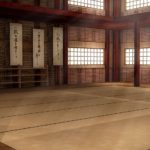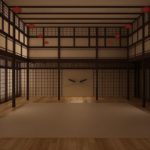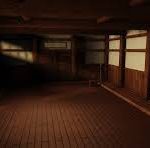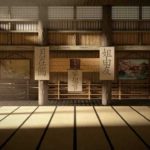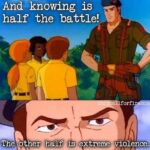Martial arts can be practiced in this room of the mansion.
–
Table of Contents:
- The Gist (Introduction)
- Quotes
- Unmatched
- The Reasons
- Three Styles Invented by the Founder
- Outlander Martial-arts Styles that Can be Taught Here
- Equipment Available Here
- Noteworthy Martial Artists Who Practice Here
- Martial Arts in Our Educational System (Images Begin)
- Look & Feel
- Badass Babes
- 2022 Update: Minecraft 1:1 Model
- Memes
–
The Gist:
One of the largest martial arts studios on the planet, this 100x150x100′ room comes complete with balancing posts, balconies, swinging chandeliers, climbing ropes, target dummies, boxing rings, smoke bomb practice areas, and every martial arts weapon that ever existed (including the specialized blades of Sayoc Kali, as well as the Shaolin Spades), all stored neatly in the gun safes and cable-locked display-racks along its perimeter (inside) walls. Stacks of boards, bricks, cinder blocks, and even giant gemstones adorn the central areas, giving practitioners opportunities to level-up from breaking plywood… all the way to punching down through pure diamond. Olympic rings and hanging hoops give the martial artists here targets to swing from, dive and spin through.
There are also punching bags filled with pebbles and broken glass; for the tougher disciplines and styles, such as Jeet Kune Do, and gis are never used (except in styles such as Judo); Inisfreean girls spar nude; no padding, no mouth-guards, ‘no nothing’. There are even a few Meteor Hammers –which you will see the short, nude, alarmingly sexy Inisfreean girls practicing with; racing around the whole dojo, back-flipping off balconies while they use them to strike targets as small as baseballs with them, shattering water-filled pots and sending projectiles thrown at them careening back toward their enemies.
Acupressure and acupuncture points are also utilized here; the art called Dim Mak. Even a weaponized version of Tai Chi is made incredible use of; a way of channeling the aura and life-force of one’s own body outward to send opponents flying backward and hurting their own bodies by tricking them into sequences of reflexive, involuntary twitching and flinching. After all, one must remember, only Master Females (Inisfreean girls who have graduated all 20 grades of the Inisfreean school system, including the most advanced special warfare training known across the Verse) are ever allowed in this house; the Governor’s Mansion, and so it is that only Inisfreean Secret Service ladies ever practice and compete in this innermost and most exclusive and restricted of Inisfreean dojos. This is a dojo where even the Grand Masters of Ninjutsu, Krav Maga, and Systema may be humbled.
–
Quotes:
It is said that “the greatest fighting style in the world is your own;” that by studying all styles you encounter, and discovering which combinations of moves from multiple styles fit your body and mind the best, you are doing the best possible thing one can do; you are inventing your own style; a ‘remix’, as it were. Inisfreeans learn martial arts styles from every noteworthy, martial-arts-practicing nation and people around the world –and beyond, such as from
- the Brazilians (Jiu Jitsu),
- Chinese (Kung Fu),
- Israelis (Krav Maga),
- Japanese (Aikido and Ninjutsu),
- Koreans (Hapkido; grappling),
- Spanish (Keysi; Batman’s main style),
- Thai (Muay Thai; kickboxing),
- and Russians (Systema),
- not to mention the Gun Katas of Equilibrium,
all of which are fluidly paired with the art of Le Parkour; ‘free-running’.
It is also said that the only warriors in the world who do not fear Marines and SEALs are those of Israel (where Krav Maga was perfected by the Kidon Mossad) and Tibet (where Kung Fu was perfected by the Shaolin warrior-monks millennia before). Naturally, it is then these two latter groups who only the Inisfreeans do not fear, for it is their exceptional fighting styles -and more- which every Inisfreean masters and takes to her own new and genius levels. How? Every Inisfreean girl (ICV) has such a “sharp” mind and senses that she instantly sees all the weak-points in any being or movement, and is able to choose the most-effective counter-movement and react/respond to them so quickly that literally no martial-arts move or other attack can ever surprise, let alone defeat, her. (*At the same time, she is also able to instantly perceive all their strongpoints and how best she might further ‘uplift’/train/enlighten them, which is usually what Inisfreeans default to, at least when dealing with people who are polite to them and their Maker.)
When you take a girl who is engineered to be flawlessly beautiful and effortlessly distracting, and give her a living supercomputer for a brain, and spend 20-years-straight teaching her everything the world (and the rest of Creation) has to offer, the result is that she and her classmates realize and refine techniques which are so clever that most humans are not even capable of imagining their beginnings, much less comprehending and executing them, much Much less anticipating or effectively defending against them. It is here in the Governor’s Mansion dojo that these amazing and lightning-quick techniques are rehearsed on a daily basis by the Governor‘s Secret Service personnel when those remarkable ladies are not on duty patrolling his estate here or standing guard.
–
Unmatched:
Inisfreeans are not physically capable of being harmed, and so even a series of (what would be to normal humans) mortal blows to their most vulnerable spots would leave them only still standing there, emotionless and waiting for their next attack or instruction. An Inisfreean girl can, for example, catch a Meteor Hammer in her fist and crush it like a paper cup, or simply teleport out of its way –or it out of her way, causing it, perhaps, to come flying right back to strike the opponent who launched it at her. Therefore when they spar with Outlanders, they tone down their abilities to less than 1% of what they are capable of; anything more would easily cripple or even disintegrate any foe. Even if these girls didn’t have such Kryptonian and god-like powers, their grand-level masteries of so many utterly lethal martial arts would leave them unchallenged on the most unforgiving of Outlander streets.
What all of the above boils down to is this: Inisfreean girls do not get sloppy or complacent due to their invincibility and superior abilities and skills; rather, they get used to fighting any number of adversaries without fatigue, dealing brilliant combinations of strikes without the possibility of having acupuncture points or energy meridians used against them, completely immune to chi attacks, and un-swayed by even the proven masters and legends from across the Asian Outlands. They know how to play dumb and use weaker moves to appear less educated, tricking greater enemies into engaging them in futile combat. They know how to recognize martial arts styles by a handful of moves or stances. They can turn the momentum of any move back on and against itself. They can even fight fluidly through smoke, fire, flash-floods, flying debris, clusters of ninja stars, and hails of gunfire. Inisfreeans evolved far beyond the ‘body-hardening’ of the Marine Corps Martial Arts Program (MCMAP); they were designed, engineered, born, and raised to be impervious to all the things which would hurt or scare the Outlanders which they now regulate.
Their motivation is in inspiring worthy Outlanders to take up the impressive course through life which led their Creator to envision, invent, and manifest all they are today and have learned. Thus, they showcase their talents on military operations in the Outlands, such as the Rapture Campaign, demonstrating first-hand just how godlike one can become if they devote themselves to it and want it badly enough. Their motivation is not merely in crippling the ugly monsters that are their natural enemies, but in liberating the minds, hearts, spirits, and bodies of those they wish to see succeed just as much as they now have. From this motivation, they draw limitless energies, always studying, exploring, meditating, inventing, and testing prototypes. Inisfreeans are incapable of complacency; just one more way they are invincible. Bodies and minds alike, Inisfreeans cannot tire.
By the time any Inisfreean girl graduates from her school in Inisfree, she has practiced and perfected* dozens of the finest martial arts from around the world… for longer than most ‘lifers’ spend earning full pensions from their companies; 20 years straight -as the bare minimum. And she’s just getting started.
…
*By “perfecting”, we mean that these girls, via their supercomputer/A.I.-minds/brains, find all the issues with all the styles of martial arts that humans hadn’t noticed yet, not just perfecting their own use of a martial-arts style, but perfecting the martial-arts style itself / styles themselves.
…
2024 February note: Ninja (a.k.a. shinobi) here can reach a level of expertise that looks like magic to outsiders. Reference (soft disclosure): Shinobi, the movie
–
The Reasons:
Why do Inisfreeans practice martial arts and stand guard when they and their entire city are invincible?
- Their Creator enjoys how sexy they are in doing so.
- It is part of the Inisfreean Way to persuade offenders by this method to cease in their offensive actions.
- Others who practice martial arts, when invited to Inisfree, can study with and learn from them here.
- Many who come to Inisfree are in charge of a lot elsewhere; they are royalty and/or business executives and/or military leaders (high-ranking officers), etc., thus they are taught from a very early age, at least in the vast majority of cases, to be able to expertly defend themselves, as so much is “riding on” their lives/health; we pride ourselves on compatibility and hospitality here in our realm, so we like to help these exemplary and crucial people maintain their skill-sets’ at peak levels.
Martial arts have a variety of profound (physical and mental) health benefits. Even if Auz wasn’t into them at all, he’d still recommend them for his people. While you won’t see them doing any fighting in their streets, you’ll always see his dojos occupied by at least one focused student.
*ICVs always know exactly how to spar so that they will ‘level-up’ their sparring partner/s the way they want/need/intend to be leveled-up; ICVs never use pointless overkill which would wear out (or even hurt) their non-ICV sparring-partners. This makes ICVs the perfect martial-arts instructors/teachers/masters. Every body-language subtlety, thought, and instinct of their sparring-partners is sensed and understood by the ICVs, and the ICVs’ reactions always perfectly instantly factor those things in. ICVs don’t even have reflexes, technically; all their movements are well-thought-out, considerate of all the people in Inisfree who are compatible with –and allied with– their Maker, High King Auz
–
Three Styles Invented by the Founder:
High King Auz invented three styles of martial arts;
- W.T.C.: weaponized Tai Chi, which allows a master to trick an opponent into twitching in sequences that hurt and disable them without being struck/touched
- F.O.A.: a fusion of all styles (beyond just Bruce Lee’s fusion of all the styles (called Jeet Kune Do) which he felt worked best for him), which removed all redundancies between the styles, such as the same strike or other move used in multiple styles while merely being called by different names
- S.T.C.: sexual Tai Chi, which allows a master to arouse, seduce, and lust-spellbind an opponent into becoming an eager servant or even a fuck-buddy
All of those styles are practiced here in this private dojo of his.
His Inisfreean girls (the ICVs) “filled in all their gaps”; he came up with the idea of the styles, explained them to these girls, and then they came up with all the moves that worked, testing them on volunteers and even themselves. As of 2022, A.D., Inisfree has, in this way, developed those 3 newly-conceived/invented styles of martial arts. They are highly effective today, and considered very eclectic and holistic/complete martial arts.
–
Outlander Martial-arts Styles that Can be Taught Here:
These are the ones you’ll usually see being practiced:
- Aikido
- Fusion-of-All
- Gun Katas
- Hapkido
- Jeet Kune Do
- Jiu Jitsu
- Karate (mostly Uechi-ryu moves)
- Keysi
- Krav Maga
- Kung Fu
- Muay Thai; kickboxing
- Ninjutsu
- Systema
- Tai Chi
- Tai Chi, sexual
- Tai Chi, weaponized
Here are 185 in-common-use styles, including some subsets:
- Aikido – Aikido is a Japanese martial arts style focused on redirecting the attack away from you. Aikido concentrates on throwing, joint locks, traditional Japanese weapons, etc.
- Aikijujitsu – Aikijujitsu is a sub-genre of Jujutsu. In contrast to Jujutsu, Aikijujitsu focuses more heavily on blending with the opponent, moving joint-locks, and other esoteric principles.
- American Kenpo – American Kenpo is a hybrid martial arts style. It is also known as Kenpo Karate.
- Angampora – Angampora is a Sri Lankan martial arts that focuses on unarmed combat, grappling, weapons and pressure points.
- Araki Ryu – Araki Ryu is a Japanese martial arts focused on traditional Japanese weapons such as the sword, spear, staff, etc.
- Bagua Zhang – The “Eight Trigram Palm” style is one of the 3 best known Wudang styles. Best known for its “circle walking”.
- Bajutsu – Bajutsu is a Japanese martial arts focused on military equestrianism.
- Bakom – Bakom (also known as Vacon) is a Peruvian martial arts that combines Jujutsu with street fighting techniques. It was designed for survival in the slums of Peru.
- Bajiquan – Bajiquan is a Chinese martial arts style that is famous for its explosive power and elbow strikes.
- Bando – Bando is a martial arts style from the Southeast Asian country of Myanmar (formerly known as Burma).
- Bartitsu – Bartitsu is an English martial arts that combines boxing, cane fighting, jujutsu, etc. Revival of this martial arts is due to renewed interest in Sherlock Holmes (as he was a fictional master of Bartitsu).
- Bataireacht (Irish Stick Fighting) – Bataireacht is the martial arts better known as Irish stick fighting.
- Bokh (Mongolian Wrestling) – Bokh is a traditional wrestling martial arts that was practiced by Mongol warriors. It is better known today as Mongolian Wrestling.
- Budokan Karate – Karate Budokan was founded in 1966 by Chew Choo Soot in Malaysia.
- Budokon – Budokon is a hybrid system that combines martial arts training with Yoga.
- Bojuka – Bojuka is a self-defense system focused on grappling and strikes to an opponent’s vital areas.
- Bojutsu – Bojutsu is a weapon-based martial arts focused on the long staff (Bo).
- Bokator – Bokator is an ancient Cambodian martial arts that includes grappling, strikes and weapons training.
- Boxing – Boxing is a martial arts style focused purely on powerful punches.
- Brazilian Jiu-Jitsu – Brazilian Jiu-Jitsu (BJJ) is a Brazilian martial arts style focused on ground fighting (i.e. grappling).
- Bujutsu – Bujutsu is the Japanese martial arts of the Samurai.
- Butthan – Butthan is a martial arts from Bangladesh. It is focused on subjects such as mediation, self-defense, weapons, etc.
- Byakuren Kaikan – Byakuren Kaikan is a Japanese martial arts focused on full contact sparring. This style originated out of Shorinji Kempo.
- Catch Wrestling – Catch Wrestling is a grappling martial arts created in the late 1800s that combines techniques from wrestling, Judo, Jujutsu and other grappling martial arts.
- Canne de Combat – Canne de Combat is a French martial arts that focuses on a sports version of cane fighting.
- Capoeira – Capoeira is a very fluid and acrobatic martial arts style from Brazil.
- Choy Li Fut – Choy Li Fut (or Cai Li Fo) is a substyle of Kung Fu that combines long and short-range techniques.
- Chun Kuk Do – Chun Kuk Do is a Korean and American hybrid system created by Chuck Norris (martial artist and movie star). In 2015, this martial arts was renamed to the Chuck Norris System.
- Combat Hapkido – Combat Hapkido is seen as a spin-off of traditional Hapkido. It has a much greater focus on self-defense and grappling than traditional Hapkido.
- Combat Hopak – Combat Hopak (or Boyovyy Hopak) is an Ukrainian martial arts supposedly derived from Cossack military traditions.
- Coreeda – Coreeda is an Australian aboriginal martial arts focused on wrestling.
- Cuong Nhu – Cuong Nhu is a Vietnamese-American hybrid martial arts that combines elements from Shotokan Karate, Aikido, Judo, Wing Chun, Vovinam, Tai Chi and Boxing.
- Daido Juku Kudo – Daido Juku Kudo is a Japanese martial arts that practices mixed martial arts techniques while wearing a traditional gi.
- Daito-Ryu Aikijujutsu – Daito-Ryu Aikijujutsu is a traditional Japanese martial arts focused on unarmed combat, throws, strikes to vital areas, joint locks, etc.
- Dambe – Dambe is an African martial arts focused primarily on boxing but it also uses kicking techniques.
- Danzan Ryu – An American hybrid form of Jujutsu. It is also known as Kodenkan.
- Defendo Alliance – This European martial arts is focused on realistic self-defense training.
- Defendu – A British martial arts created by William Fairbairn and Eric Sykes. This system was taught to Office of Strategic Services agents and Allied troops in World War 2.
- Dumog – Dumog is a Philippine martial arts focused on wrestling.
- Dutch Kickboxing – Dutch Kickboxing was formally developed in the 1970s and is often seen as a modified version of Muay Thai.
- Eagle Claw Kung Fu – Eagle Claw Kung Fu is a Chinese martial arts known for its gripping techniques, strikes, joint locks, takedowns and pressure point attacks.
- Enshin Kaikan – Enshin Kaikan is a Japanese martial arts that utilizes the Sabaki method (which seeks to turn an attacker’s power against him). This martial arts involves kicks, punches, sweeps, throws, etc.
- Eskrima, Arnis & Kali – Eskrima is a martial arts style from the Philippines focused on the use of stick and blade weapons (i.e. Yantok). This martial arts is also known as Arnis and Kali.
- Fencing – Fencing today is mainly an Olympic-style sport. However, there is a sub-style called historical fencing which focuses on fencing as a martial arts.
- Fu Jow Pai – Fu Jow Pai is a Chinese martial famous for its “Tiger Claw” style.
- Gatka – Gatka is an Indian martial arts focused on weapons, especially swords.
- Glima – Glima is a Scandinavian wrestling-based martial arts that was created by the Vikings.
- Gongkwon Yusul – Gongkwon Yusul is a Korean hybrid martial arts that includes elements from Hapkido, Jujutsu, Judo and Boxing.
- Gungsol – Gungsol or Gungdo is a Korean martial arts focused on archery.
- Haidong Gumdo – Haidong Gumdo is a Korean martial arts focused on sword techniques. It contains elements similar to Kenjutsu and Iaido.
- Hanbojutsu – Hanbojutsu is a martial arts that utilizes the Hanbo (a 3 foot wooden staff).
- Han Mu Do – Han Mu Do (or Hanmudo) is a Korean martial arts style. It is seen as a “smoother” and more “open hand” cousin to
- Hapkido – Hapkido is a Korean martial arts style focused on punches, kicks, throws and joint locks.
- HEMA – Historical European Martial Arts – HEMA refers to mainly sword-based martial arts based on techniques used in Europe from around the 1300s to the 1800s.
- Hojojutsu – Hojojutsu is a Japanese martial arts that uses ropes to restrain or disable an opponent.
- Hung Ga – Hung Ga (or Hung Gar) is a southern Chinese martial arts that combines 5 animal styles (Crane, Dragon, Leopard, Snake and Tiger).
- Huyen Langlon – Huyen Langlon is a martial arts from northeastern India.
- Hwa Rang Do – Hwa Rang Do is a Korean martial arts that includes sparring, self-defense, weapons training and grappling.
- Iaido – Iaido is a Japanese martial arts focused on the drawing of a sword (bokken, iaito or shinken) from its scabbard. This martial arts relies heavily on katas (forms) and does not utilize sparring.
- Iaijutsu – Iaijutsu is the combat version of Iaido.
- Icho-Ryu – Icho-Ryu is a fusion of martial arts such as Aikido, Goju Ryu Karate, Jujutsu, Judo and Aikijujutsu. It was created to meet the needs of law enforcement officers.
- Itto-Ryu – A Japanese martial arts focused on the sword. There are many sub-styles of Itto-Ryu and this martial arts had significant influence on the development of modern Kendo.
- Jailhouse Rock – Jailhouse Rock (JHR) is a martial arts system that was developed in the US prison system.
- Jeet Kune Do – Jeet Kune Do is a martial arts style created by Bruce Lee (martial artist and movie star).
- Jojutsu – Jojutsu (or Jodo) is a Japanese martial arts focused on the short staff (Jo).
- Judo – Judo is a Japanese martial arts style focused on grappling, joint locks and throws.
- Jujutsu – Jujutsu is a Japanese martial arts style focused on joint locks, holds and throws. It tries to redirect or manipulate the force of an attack in order to defeat the attacker.
- Jukendo – Jukendo is a Japanese martial arts focused on the bayonet.
- Juttejutsu – Juttejutsu is a Japanese martial arts that focuses on the martial arts weapon known as the Jutte (Jitte).
- Kajukenbo – This is an American martial arts style that combines techniques from many different martial arts such as Judo, Karate, Eskrima, etc. It was designed to be effective in real world self-defense situations and street fights.
- Kalaripayattu – Kalaripayattu is an ancient martial arts style from India.
- KAPAP – KAPAP is the Hebrew acronym for Face-To-Face-Combat. While not as well known as Krav Maga, this Israeli martial arts system is used by a number of Israel’s elite military units.
- Karate – Karate is a Japanese martial arts style focused on punches, hand/elbow strikes, knee strikes and kicks. Major Karate styles include the following:
Goju-Ryu
Isshin-Ryu
Kyokushin
Shito-Ryu
Shorin-Ryu
Shotokan
Wado-Ryu
For other Karate styles, please visit the main Karate section. - Keijojutsu – Keijojutsu is a Japanese martial arts focused on police stick fighting (batons).
- Kendo – Kendo is a Japanese martial arts style focused on sword fighting (i.e. Bokken and Katana).
- Kenjutsu – Kenjutsu is a Japanese martial arts style focused on sword techniques. In contrast to Kendo, Kenjutsu is less focused on sparring.
- Kenpo or Kempo – Please visit the American Kenpo section.
- Keysi – The Keysi Fighting Method is a self-defense system “created to act and react while defending yourself”. This system has been featured in movies such as the Batman series that starred Christian Bale.
- Kickboxing – Kickboxing is a martial arts style focused on powerful kicks and punches.
- Kinomichi – Kinomichi is a martial arts style that originated in France and was developed by one of the students of the founder of Aikido.
- Kino Mutai – Kino Mutai (Kina Mutai) is a Philippines martial arts that uses unconventional tactics such as biting and eye-gouging.
- Kobudo – A Japanese (Okinawan) martial arts focused on weapons training. Weapons used include the bo staff, sai, tonfa and nunchaku.
- Kokondo – Kokondo is a style that combines techniques from Karate and Jujutsu.
- Krabi-Krabong – Krabi-Krabong is a weapon-based martial arts from Thailand.
- Krav Maga – Krav Maga is a martial arts style from Israel focused on winning in “real life” combat situations.
- Kuk Sool Won – Kuk Sool Won is a Korean martial arts focused on strikes, kicks, grappling, joint locks, weapons training and healing techniques.
- Kumdo – Kumdo is a Korean sword-based martial arts which is similar to Kendo.
- Kung Fu – Kung Fu is a Chinese martial arts style focused on hand/arm strikes, kicks and even weapons training. Please see the main Chinese martial arts styles section for more Kung Fu styles but listed below are a few of the many different Kung Fu styles:
Bajiquan
Choy Li Fut – Also known as Cai Li Fo.
Eagle Claw Kung Fu
Hung Ga – Also known as Hung Gar.
Leopard Kung Fu (Bao Quan)
Monkey Kung Fu (Hou Quan)
Praying Mantis Kung Fu
Shaolin Kung Fu
Tiger Claw Kung Fu (Fu Jow Pai)
Zui Quan – Zui Quan is better known as the “Drunken Fist” style. - Kung Fu To’a – Kung Fu To’a is an Iranian martial arts style that combines Kung Fu and Yoga.
- Kuntao – Kuntao is a southeast Asian martial arts that utilizes hand strikes, kicking techniques, grappling and martial arts weapons (i.e. sword, staff and spear).
- Kyudo – Kyudo is a Japanese martial arts style focused on archery.
- Kyujutsu
- Kyuk Too Ki – Korean kickboxing.
- Kyusho Jitsu – A martial arts focused on targeting pressure points.
- Laamb – Laamb is a Senegalese martial arts that combines wrestling and punches.
- Lathi Khela – Lathi Khela is a Bangladeshi stick-fighting martial arts.
- Lerdrit – Lerdrit is a military martial arts used by the Royal Thai Army.
- Leopard Kung Fu (Bao Quan) – Leopard Kung Fu is a Chinese martial arts that focuses on aggressive speed and agility to defeat an opponent.
- Lethwei – Lethwei is a Myanmar (Burma) martial arts that is similar to Muay Thai and Kickboxing. However, Lethwei has less restrictions as this martial arts allows techniques such as headbutts.
- LimaLama – A martial arts from Samoa.
- Linh Quyen Dao – Linh Quyen Dao is a Vietnamese martial arts.
- Lua – Lua is a traditional Hawaiian martial arts that focuses on bone breaking, boxing, wrestling, weapons, etc.
- Luta Livre – Luta Livre is a Brazilian grappling martial arts known in Portuguese as “Free Fighting”.
- Malla Yuddha – Malla Yuddha is an Indian and Southeast Asian martial arts focused on combat wrestling.
- Marine Corps Martial Arts Program (MCMAP) – The Marine Corps Martial Arts Program is focused on unarmed combat, knife training, bayonet techniques, etc.
- Mau Rakau – Mau Rakau is a weapons-based martial arts developed by the Maori of New Zealand.
- Military Martial Arts – Military martial arts are martial arts styles used by and/or developed for the military. They are designed for real-life combat situations versus sport-based martial arts that ban certain techniques in order to avoid injuries.
- Mixed Martial Arts – Mixed Martial Arts utilizes techniques from a variety of different martial arts styles (i.e. wresting, jiu-jitsu, boxing, karate, etc.) in order to defeat an opponent.
- Monkey Kung Fu (Hou Quan) – Monkey Kung Fu is an unorthodox and acrobatic style used to disorient and attack opponents from unusual angles and positions.
- Muay Boran – Muay Boran is a Thai martial arts. Modern Muay Thai evolved from this martial arts style.
- Muay Thai – Muay Thai is a martial arts style from Thailand. It is similar to kickboxing but also involves elbow and knee strikes. Given its powerful kicks and knee strikes, Muay Thai is often an element of MMA training.
- Naginatajutsu – Naginatajutsu is a Japanese martial arts style focused on the long pole weapon known as the Naginata.
- Nam Hong Son – Nam Hong Son is a Vietnamese martial arts.
- Nhat Nam – Nhat Nam is a Vietnamese martial arts.
- Ninjutsu – Ninjutsu is a martial arts style developed from the techniques used by ninjas (Japanese spies and assassins).
- Nippon Kempo – Nippon Kempo is a Japanese martial arts that uses punches, kicks, joint locks and grappling techniques.
- Niten Ichi-Ryu – Niten Ichi-Ryu is a two sword martial arts style created by the famous Japanese samurai, Miyamoto Musashi.
- Niyuddha – Niyuddha is an ancient Indian martial arts focused on kicking, punching and throwing.
- Nunchaku Do – Nunchaku Do is a martial arts focused on the sports usage of the Nunchaku(Nunchucks).
- Nunchakujutsu
- Okichitaw – Okichitaw is a hybrid martial arts that combines the traditional fighting techniques used by the Cree Indians (Native Americans) with techniques from martial arts such as Taekwondo and Judo.
- Panantukan – Panantukan is the boxing component of Filipino martial arts. Panantukan is not a sport, but rather a street-oriented fighting system. This martial arts is also known as Suntukan, Pangamot, Pakamot and Mano-Mano.
- Pankration – This Greek martial arts style combines grappling, kicking techniques and boxing. It was part of the first Olympics in 648 BC.
- Pehlwani – Pehlwani is an Indian martial arts focused on wrestling & grappling techniques.
- Pencak Silat – Pencak Silat is the name used to refer to a variety of Indonesian martial arts.
- Pradal Serey – Pradal Serey is a Cambodian martial arts similar to Muay Thai and Kickboxing. Pradal Serey is well known for its use of elbow strikes in order to win a fight.
- Praying Mantis Kung Fu – Praying Mantis Kung Fu is known for its redirection, joint manipulation, pressure point attacks and trapping tactics.
- Quarterstaff – The British martial arts that uses a 6-9 foot wooden staff. Famous from the tales of Robin Hood.
- Qwan Ki Do – Qwan Ki Do (Quan Khi Do) is a Vietnamese martial arts founded by Pham Xuan Tong in the 1960s.
- Sambo – Sambo is a Russian martial arts style. There are two main types of Sambo; Combat Sambo and Sports Sambo.
- Sanshou (or Sanda) – Sanshou is a martial arts style developed for the Chinese military. It is focused on combat training and combines elements of kung fu, grappling and self-defense techniques.
- Savate (French Kickboxing) – Savate is a French martial arts style focused on boxing and kicking. No knee strikes are allowed.
- Schwingen – Schwingen is a Swiss martial arts focused on grappling.
- Shaolin Kempo Karate – Shaolin Kempo Karate is a hybrid martial arts that combines techniques from Shaolin Kung Fu, Karate and Asian wrestling.
- Shaolin Kung Fu – Shaolin Kung Fu is a well known style of Kung Fu. This martial arts was developed by the monks at the Shaolin Temple in China.
- Shin Kicking – Shin Kicking is an English martial arts or combat sports where the contestants kick each other in the shins until one withdraws from the contest.
- Shindo Jinen Ryu – Shindo Jinen Ryu is a martial arts that combines elements of Karate, Aikido & Jujutsu.
- Shintaido – Shintaido is a martial arts that combines Karate, Kenjutsu and Bojutsu with spiritual and mediation elements.
- Shootfighting – Shootfighting is a combat sport similar to Mixed Martial Arts. It is focused on techniques from “Muay Thai Kickboxing and total body Submission Grappling”.
- Shooto – This Japanese martial arts style is similar to mixed martial arts and was created by Satoru Sayama.
- Shorinji Kempo – A Japanese martial arts that combines personal growth, health and spirituality with self-defense techniques such as punches, kicks, escapes, throws, etc. It is seen as a modified Japanese version of Shaolin Kung Fu and was established in 1947.
- Shuai Jiao – A Chinese martial arts focused mainly on wrestling and grappling techniques.
- Shuri-Ryu – Shuri-Ryu is a martial arts that combines elements of Karate and Kung Fu.
- Sibpalki – Sibpalki is a Korean martial arts that teaches close combat skills that were utilized in the late 1700s.
- Sikaran – Sikaran is a Philippines martial arts focused almost exclusively on kicking.
- Silambam – Silambam is an Indian martial arts focused primarily on staff fighting.
- Silat – Silat is a Southeast Asian martial arts style focused on strikes (i.e. elbow and knee), throws, takedowns and weapons training.
- Siljun Dobup – Siljun Dobup is a sword-based martial arts based on Japanese and Korean traditions.
- Singlestick – This ancient English martial arts uses a wooden rod to practice techniques that were originally designed to teach cutlass fighting to sailors.
- Small Circle Jujitsu – Small Circle Jujitsu is an American martial arts. It is a hybrid grappling system and utilizes modified techniques from martial arts such as Jujutsu, Judo and others.
- Sojutsu – Sojutsu is a Japanese martial arts focused on spear fighting.
- Soo Bahk Do – Soo Bahk Do is a Korean martial arts that grew out of Tang Soo Do.
- Special Combat Aggressive Reactionary System (SCARS) – This martial arts program was taught to US Navy Seals in the 1980s and 1990s.
- Spochan – Spochan is a martial arts that uses “air soft” weapons to practice various sword & stick-based fighting techniques.
- Ssireum – Ssireum is a Korean martial arts focused on wrestling.
- Sumo – Sumo is a Japanese martial arts focused on wrestling.
- Systema – Systema is a martial arts style used by some Russian special forces (i.e. Spetsnaz).
- Taekkyeon – Taekkyeon ia a Korean martial arts focused on low kicks, leg sweeps, trips, pushes, etc.
- Taekwondo – Taekwondo is a Korean martial arts style focused primarily on punches, blocks, strikes and kicks (i.e. spinning hook kick).
- Tahtib – Tahtib is an Egyptian martial arts focused on stick fighting. Students generally train with a 4 foot wooden stick.
- Tai Chi – Tai Chi is often seen as a “gentle” martial art because many seniors use its slow movements in order to improve their health & balance and to reduce stress.
- Taido – Taido is a Japanese martial arts that combines elements of Karate with gymnastic maneuvers & dynamic movement.
- Taiho Jutsu – Taiho Jutsu is a Japanese martial arts that was originally designed to help feudal police arrest armed criminals.
- Tang Soo Do – Tang Soo Do is a Korean martial arts style that is similar to Taekwondo and Karate.
- Tantojutsu
- Teukgong Moosool – Teukgong Moosool (or Tukong Moosul) is a martial arts that was developed by South Korean special forces units.
- Tessenjutsu – Tessenjutsu is a Japanese martial arts based on the use of Tessen (war fans).
- Thien Mon Dao – Thien Mon Dao is a Vietnamese martial arts.
- To-Shin Do – A “modernized” version of Ninjutsu.
- US Army’s Modern Army Combatives Program – This is the martial arts program taught by the U.S. Army.
- Vale Tudo – Vale Tudo is a Brazilian martial arts system that is similar to Mixed Martial Arts but with even fewer rules. The limited number of rules can result in more injuries during Vale Tudo contests.
- Varma Kalai – Varma Kalai is an Indian martial arts focused on pressure points. They claim that is also used for healing applications.
- Vovinam – Vovinam is a Vietnamese martial arts style.
- Wing Chun – Wing Chun is a Chinese martial arts style focused on strikes, grappling and weapons training.
- Won Hwa Do – Won Hwa Do (or WonHwaDo) is a Korean martial arts known for its circular techniques.
- Wrestling – Wrestling, while used mainly for sports today, is an ancient martial arts style of fighting. It focuses on grappling, throws and “pinning” your opponent.
- Wushu – Wushu is the modern-day sports version of Kung Fu. Wushu was developed in the 1950s as an attempt to unify the multitude of traditional Chinese martial arts into one national style.
- Xtreme Martial Arts – Xtreme Martial Arts (XMA) combines gymnastics with martial arts techniques in order to create acrobatic martial arts “tricks”.
- Yabusame – Yabusame is a Japanese martial arts focused on archery while mounted on horseback.
- Yamanni-Ryu – Yamanni-Ryu is a martial arts style that focuses on training with Okinawan weapons (Kobudo).
- Yaw Yan – Yaw Yan is a Philippine kickboxing martial arts. It also utilizes grappling techniques and defenses against weapons.
- Yongmudo – Yongmudo (Yongmoodo) is a Korean martial arts style that combines techniques from martial arts such as Taekwondo, Judo and Ssireum.
- Yoseikan Budo – Yoseikan Budo is a Japanese martial arts system that combines a number of different martial arts including Aikido, Jujutsu, Judo, Karate, Kobudo and Boxing.
- Zui Quan – Zui Quan is better known as the “Drunken Fist” style of Kung Fu.
- Zulu Stick Fighting – Zulu stick fighting is a South African weapons-based martial arts.
Being Inisfreeans, we have full knowledge of all other types, and can teach any/all of them, by request / on demand.
–
Equipment Available Here
Basic:
- bombs, smoke (tiny; handheld/thrown)
- gloves/mitts, boxing/focus
- headgear (padded helmet)
- jars, gripping (for Nigiri Game)
- punching bag
- guards, bite
- guards, shin
- rings, still (hoops you jump through)
- striking dummy, wooden (for Wing Chun)
Traditional Okinawan & Japanese Martial Arts Training Equipment:
- Chi Ishi – Stone weighted training tools for upper body conditioning.
- Ishi – A large rock that was carried around in order to build strength and conditioning.
- Ishi Sashi – Stone or concrete hand weights.
- Jari Bako – This Japanese training tool uses a bucket filled with sand to condition fingers and hands.
- Kakite Bikei – Blocking post with movable arm.
- Kongoken – A large heavy iron ring used for full body strength training and conditioning.
- Makiage Kigu (Wrist Roller) – Weighted rope used to build hand, wrist and forearm strength.
- Makiwara – A wooden striking post which provides progressive resistance.
- Nigiri Game (Gripping Jars) – Gripping jars used to develop palm and finger strength.
- Sagi Makiwara – A hanging version of the Makiwara.
- Suburito – Also known as the Suburi Bokken, an extra heavy wooden practice sword for building arm and shoulder strength.
- Sunabukuro – Similar to modern day heavy bags.
- Taketaba – Bundle of bamboo used for finger strikes, etc.
- Tan – Barbell with wooden handle.
- Tanren Bo – The Tanren Bo is a wooden device used ‘solely’ for conditioning the wrists and arms.
- Tetsu Geta (Iron Sandals) – a Karate training tool known as “Iron Sandals” or “Iron Clogs” used to strengthen the legs and develop kicking power
- Tetsuwa (Iron Bracelets) – These are iron weights that are worn on a student’s wrist to build arm and shoulder strength.
- Ude Makiwara – round version of the Makiwara striking post
Training & Practice Weapons:
- Bokken – Wooden practice sword.
- Iaito – Unsharpened metal practice sword.
- Shinai – Bamboo practice sword used in Japanese martial arts such as Kendo. This practice weapon is also used to simulate defense against an opponent armed with a club/bat, etc.
- Foam versions of martial arts training weapons (i.e. Nunchaku). These allow students to train with traditional martial arts weapons without injuring themselves or others. Great for beginners before they advance to the real thing.
- Foam Bo
- Foam Esckrima Sticks
- Foam Kama
- Foam Katana
- Foam Nunchaku
- Foam Three Section Staffs
- Foam Tonfa
- Rubber Batons & Clubs – Rubber batons & clubs are used to practice unarmed self-defense techniques against an attacker armed with a baseball bat, clubs, etc.
- Rubber Guns – Rubber guns are used to practice self-defense techniques by martial arts such as Krav Maga. Students practice how to disarm an attacker armed with a gun.
- Rubber Knives – Rubber knives are used to practice self-defense techniques by martial arts such as Krav Maga.
- For more advanced training blunt metal knives can be used, or the sharkee knife which can be covered in chalk so it is clear if the attacker would have cut you or not.
- Shock Knives – Shock knives are martial arts & self-defense training tools that produce an electric shock if the blade touches your training partner. It is supposed to let a training partner “feel” if they would have been cut in a real-life attack.
Modern Martial Arts Training Equipment:
- Body Opponent Bag (BOB)
- Double End Bags
- Foam versions of traditional martial arts training weapons (i.e. Nunchaku). These allow students to train with softer versions of traditional martial arts weapons and thus lower the possibility of injuring themselves or others. Great for beginners before they advance to the real thing.
Foam Bo
Foam Esckrima Sticks
Foam Kama
Foam Katana
Foam Nunchaku
Foam Three Section Staffs
Foam Tonfa - Focus Mitts – This training tool is also known as Punch Mitts, Punching Mitts, etc.
- Grappling Dummies
- Heavy Bags
- Kicking Bag – This section focuses on kicking bags such as Wavemaster, BOB (Body Opponent Bag), etc.
- Kicking Paddle – A kicking paddle is often used for accuracy training.
- Kicking Shield – This martial arts training tool is used for “power” kicks while on the move.
- Muay Thai Belly Pad – This tool is also known as a MMA Belly Pad.
- Rebreakable Boards – This training tool is used to practice breaking techniques (i.e. with a knife hand strike or back kick). Over the long-term, they are cheaper than buying numerous wooden boards.
- Reflex Bag – This is a training tool used for punches and strikes. It is often used by boxers.
- Rubber Batons & Clubs – Rubber batons & clubs are used to practice unarmed self-defense techniques against an attacker armed with a baseball bat, clubs, etc.
- Rubber Guns – Rubber guns are used to practice self-defense techniques by martial arts such as Krav Maga. Students practice how to disarm an attacker armed with a gun.
- Rubber Knives – Rubber knives are used to practice self-defense techniques by martial arts such as Krav Maga.
- Self-Defense Training Suits – Heavily padded suits designed to protect training partners during self-defense practice.
- Shock Knives – Shock knives are martial arts & self-defense training tools that produce an electric shock if the blade touches your training partner. It is supposed to let a training partner “feel” if they would have been cut in a real-life attack.
- Speed Bag
- Tennis Ball Double End Bags
- Tennis Ball Punching Bags
- Thai Pads – Forearm pads
Breakable Items:
- boards
- bricks
- ceramic pots (hung for meteor-hammer and/or rope-dart practice)
- cinder blocks
- gemstone tablets
Weapons:
- ax
- blades, Sayoc Kali
- blunt;
baton
club
knuckleduster (brass knuckles)
mace
staff/stick
tonfa (side-handled baton) - dagger
- flexible;
chain
nunchaku
rope
slapjack
tabak-toyok (like nunchaku)
whip - kama
- meteor hammer
- polearms;
guandao
halberd
spear
war scythe - ranged;
blowgun
bow & arrows
crossbow
firearms (though no ammo./shooting is allowed in this room)
knife, ballistic (throwing)
ninja star
shuriken
sling
taser - spade, Shaolin
- sickle
- sword
- war hammer
All weapons used in martial arts are listed here.
–
Noteworthy Martial Artists Who Practice Here:
Whenever these amazing people are in Inisfree and have the time, they like to come to this special dojo to keep their skills world-class sharp, always enjoying (at least for a portion of their time here) the assistance of the ICVs here at those times.
- Alexia: SPA field agent
- Alison Hart-Burnett: “Lady Jaye”
- Azure: another of The Eternals
- Carmilla Black: “Scorpion”, the clubber & assassin with the green arm
- Coleen Wing: refugee from, and former martial-arts student of, “The Hand”
- Diana Prince: “Wonder Woman”, daughter of Zeus, now a goddess warrior
- Elizabeth Braddock: Psylocke
- Felicia Hardy: “Black Cat”, an X-Man
- Gamora Zen Whoberi Ben Titan: a green-skinned assassin, and a Guardian of the Galaxy
- Helena Wayne: heiress of Wayne Enterprises
- Illyana Rasputina: descendant of the legendary Russian healer chosen by the royal family, she has become entrusted with one of the Infinity Gems, and can regularly access Purgatory and other dimensions, even teleporting other people with her
- Kendra Saunders: “Hawkgirl”
- Lara Croft: even more of an expert on tombs and ruins than Indiana Jones
- Lin Mae: commander of the Crane Corps of the Great Wall of China, many generations ago
- Maria Hill: a former Director of SHIELD
- Max Guevara: a human clone whose DNA was spliced with various animals’ (designation X5-332960073452)
- Miranda Lawson: a Cerberus officer (yes, she was kept alive by Inisfree contact)
- Narissa: first Romulan welcomed to Inisfree
- Natasha Romanoff: “Black Widow” (PB Angie Everhart), Russian network
- Naurhin: elf ranger met in Italy northwest of rebuilt Rome
- Nyssa Damaskinos: a pure-blood vampire princess from Prague, daughter of vampire overlord Eli Damaskinos, she now resurrected and stabilized, representing all the vampires of that nation
- Quorra: first Tron person welcomed to Inisfree
- Rain Ocampo: USCMC pilot (of the UD-4L “Cheyenne” Dropship)
- Roxanne Morton: a British spy assumed KIA
- Selene (of Viktor of Marcus Corvinus): former Death Dealer (Lycan huntress; killer of werewolves), now mother of a vampire-werewolf hybrid, and representing all the vampires of Hungary
- Shelwe Taldeer: ancient Space-Elf leader
- Valeera Sanguinar: Blood Elf thief and warrior
- Wendy Temujin: ancient Chinese goddess
- Windrunner triplets: Alleria, Sylvanas, and Vereesa; beautiful Blood Elves
- Xull’rae Zauviir: dark-priestess and princess from the Underdark of Earth; the cave network realms where the Drow (Dark Elves) live
–
Martial Arts in Our Educational System:
Students of Inisfree’s schools have ~20 years of martial arts practice/expertise before coming/training to this private/elite dojo.
ICVs are naked except for their colored rank-belt.
–
Look & Feel:
–
Badass Babes:
–
2022 Update: Minecraft 1:1 Model
–
Memes:
–
Also see:
–

